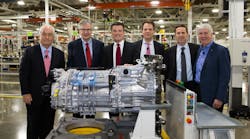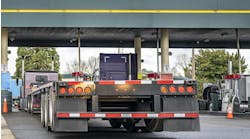REDFORD, MI. Representing a $100-million investment in the Detroit Powertrain plant here, Daimler Trucks kicked off full production of its DT12 automated mechanical transmission with a celebration that included the governor of Michigan Rick Snyder, former owner of the company Roger Penske and the entire plant workforce as well as Daimler Trucks and Buses head Werner Bernhard and Daimler Trucks North America president and CEO Martin Daum.
The heavy-duty transmission line fills in the missing link in DTNA’s integrated powertrain production in the U.S. The plant now builds Detroit 13, 15 and 16-liter diesels and Detroit drive axles as well as the AMT. Previously DT12s for Freightliner and Western Star trucks were imported from a Daimler plant in Germany.
In addition, the company announced during the celebration that it would invest another $375 million in the plant to add medium-duty diesel production by the end of 2018. Until that line is up and running, the company will import DD5 5-liter and DD8 8-liter diesels from it Mannheim, Germany plant.
Roger Penske, who bought what was considered a moribund Detroit Diesel from General Motors in 1988, received a raucous welcome from the plant employees when he took the stage at the DT12 event. As a division of GM, it had lost $600 million for three years in a row and was infamous for union/management discord. Penske was widely credited for turning the company around, launching successful new engine products and eventually selling the revived plant and business to Daimler.
Despite the grim conditions, “I found people, I found human capital, I found people who wanted to win and who were committed, and that’s all me needed,” Penske told the crowd. “Within five years, we went from 3% market share to 33% market share. We won because of the people…. So congratulations today, great job.”
At a later press conference, Daum said the decision to add proprietary medium-duty engines would not alter DTNA’s relationship with Cummins, which currently provides all of the company’s MD diesels. DTNA will continue its two-supplier strategy, offering customers the choice of Cummins or Detroit MD engines, he said, just as it currently offers third-party options for heavy-duty engines, axles and transmissions.
Asked if Daimler might also bring a medium-duty automated mechanical transmission to North American, Daum said the company was approaching its platform integration strategy “step by step.” With the HD Detroit engines representing the first step and the DT12 the second, “the third step is the medium-duty engines,” he said. “We’ll see how that goes before a decision on [MD] transmissions.”



